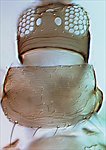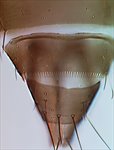
claratris head & pronotum

claratris meso & metanota

claratris tergites VII-X

claratris sternite VII

claratris male sternites V-VII
Generic diagnosis
Female macropterous. Head with three pairs of ocellar setae; pair I with the two setae usually arising one in front of the other; ocellar setae pair III arising within ocellar triangle; maxillary palps 3-segmented; eyes without or with five pigmented facets. Antennae 8-segmented, segment I with paired dorso-apical setae; segments III and IV with forked sense cones; III–VI with microtrichia on both surfaces. Pronotum with two pairs of posteroangular setae, 3–4 pairs of posteromarginal setae. Mesonotum with median setae close to posterior margin, anterior campaniform sensilla present or absent. Metanotum reticulate, median setae at anterior margin, campaniform sensilla present or absent. Fore wing first vein with about seven setae basally, two setae distally; second vein with complete row; discal seta present or absent on clavus. Prosternal ferna entire, basantra without setae; mesothoracic sternopleural sutures complete, mesofurcal spinula present, metafurcal spinula absent. Tarsi 2-segmented. Tergites without ctenidia, median setae far apart, VI–VII with setae S3 much smaller than S4; tergite VIII posterior margin with complete comb of microtrichia; IX with two pairs of campaniform sensilla; X with complete dorsal split. Sternites III–VI with 3 pairs of marginal setae, VII with S1 and S2 arising well in front of posterior margin.
Male tergite IX with median setae slender or slightly stout; sternites III–VII with 2 or more rows of small pore plates.
Biological data
Apparently leaf-feeding, claratris is recorded as a pest of tomato plants in Thailand.
Distribution data
Of the five species in this genus, three are known only from Africa. However, brunneus is now widely dispersed and recorded as common in parts of Malaysia as well as being in Puerto Rico (Mound & Nickle, 2009). The name claratris is applied to a species recorded from India, Tibet, Yunnan, Thailand and the Philippines, but this species is not clearly distinguished from cameroni that was described from Sudan.
Nomenclatural data
Ceratothripoides Bagnall, 1918: 201. Type species Ceratothripoides brunneus Bagnall, 1918, by monotypy.
Five species are recognised in this genus (ThripsWiki, 2020), of which only one is known from China:
claratris (Shumsher, 1946: 178). (Taeniothrips)
Relationship data
Thripidae sub-family Thripinae: this is a diverse group involving more than 230 genera. Ceratothripoides species share with the species of the Megalurothrips group of genera the presence of a pair of dorso-apical setae on the first antennal segment. In this it also ressembles species of Pezothrips, and with members of that genus it also shares the presence of multiple small pore plates on the male sternites.
References
Mound LA & Nickle DA (2009) The Old-World genus Ceratothripoides (Thysanoptera: Thripidae) with a new genus for related New-World species. Zootaxa 2230: 57–63.
ThripsWiki (2020) ThripsWiki - providing information on the World's thrips. <http://thrips.info/wiki/Main_Page>
Xie YH, Zhang HR, Li ZY, Sun YX & Lu YB (2012) A virus vector species of Ceratothripoides new to China (Thysanoptera: Thripidae). Entomotaxonomia 34 (1): 30–34.